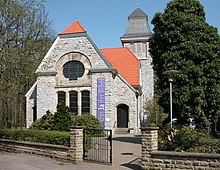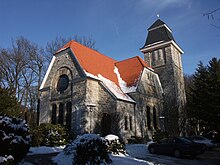Neander Church (Erkrath)
The Protestant Neander church in today Erkrather district Hochdahl is after the church hymn writer Joachim Neander named. It stands in close proximity to the Neandertal, which is also named after him .
Establishing church and congregation
As a result of the stormy development of the region's industry and, above all, the construction of the railway line of the Düsseldorf-Elberfelder Eisenbahn-Gesellschaft from 1837 to 1841 from Düsseldorf to Elberfeld (now part of Wuppertal ), both educated and wealthy Protestant industrialists came to build villas here , as well as Protestant Prussian officials from the railway, post office and administration and numerous industrial workers in the area, so that the need for their own church support arose. For example, Adolf Boeddinghaus, a textile manufacturer from Elberfeld, who had his villa “Neanderhöhe” built by the Elberfeld architect Heinrich Plange near Hochdaler Feldhof, initiated a church building association in 1899, for which he had ten dignitaries , hut director, station master , post administrator, landowner and the medical councilor Karl Sudhoff was able to win, and which grew to 53 by the official founding day on January 7, 1900 and to over 90 members by the start of construction. After Boeddinghaus increased the initial capital of around 8,000 Marks twice to over half the construction costs of 45,000 Marks, the church was built, appropriately equipped and, after two years of construction, inaugurated on July 23, 1905 by the Erkrath pastor and superintendent Friedrich Wilhelm Bleier. The celebration began with the Neander song " Praise the Lord" sung by the children's choir . At the request of the building association, the church was named after Joachim Neander (the 200 years older church in Düsseldorf, in whose parish Neander once served, was only renamed after Neander in 1916).
The number of parishioners who attended the new church grew, so that negotiations were conducted with the church leadership and the Erkrath parish in order to constitute a separate parish. This could be formed on April 1, 1926, but remained connected to Erkrath in the pastoral office. Through further negotiations together with consolidations from the communities in Mettmann and Gruiten , a separate pastor's office should also be achieved. Since 1924 Hochdahl was assigned an assistant preacher position after a parsonage had been built. The first ordinary pastor in Hochdahl was then Pastor von Derschau from 1946. This broke the last bond with Erkrath. By 1973, two more parish offices were created for the Millrath and Sandheide districts. In 1977 a fourth was added for Willbeck. The congregation currently has around 8,000 souls and, since 2001, three pastors who oversee several preaching sites, including an ecumenical house of the churches in the city center on the market.
Building description
The church is built from broken limestone in the nearby Mettmann Valley, the side valley of the Neandertal, and the window frames are made of sandstone. Due to the rustic -looking construction in natural stone, it has a mixed style that is somewhat based on the Wilhelmine style and historicism , combined with Art Nouveau elements, especially in the interior. It was built by the house architect of the entrepreneur Boeddinghaus, Heinrich Plange . The church has the shape of two crossing naves with hunched roofs and a laterally offset tower, which with its square, stepped helmet only slightly towers over the church. The chime consists of two steel bells in A and F sharp from the Bochum Association , which are still in service today. The transept is a little lower than the nave and only protrudes slightly from the structure. Because the roof is supported on the inside by columns, the interior acts as a central structure. In 1908 an organ was installed in the chancel. In 1971 the church got a new organ.
In 1954 the interior of the church underwent a thorough renovation, during which the installation of a gallery for the organ created space for an additional 50 people to attend the service. A large wooden cross now adorns the chancel. In 2000, the roof and outer walls were renovated.
The church has been open since October 2004 , which means that it is open every day of the week, usually from 10 a.m. to 4 p.m.
Church foundation
The commitment of Hochdahler citizens from the beginnings of the church continues today, even in the present time, despite changing requirements. An anonymous donor, a business consultant, donated the largest part of the share capital of 50,000 DM to a church foundation to support the tasks of the community. This capital grew to around € 288,000 in 2011 through donations from Protestant Hochdahler citizens.
Web links
- Website on the history of the Neander Church by Lothar Euler (links to the history of the congregation and the church jubilee, accessed February 2009)
- Picture of the church at Cityreview
Coordinates: 51 ° 13 ′ 13 ″ N , 6 ° 56 ′ 33 ″ E


